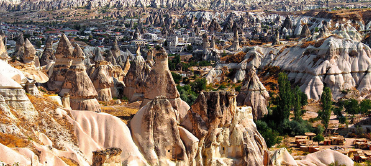THE STORY BEHIND THE FAIRY CHIMNEYS
Cappadocia’s famous ‘fairy chimneys’, a surreal landscape of rock formations, change colour with every sunset. But how did these strange natural growths emerge? Let’s take a look at the tale behind Turkey’s most majestic rocks.
The rock formations emerged due to a geological process that began millions of years ago. Ancient volcanic eruptions covered the region in thick ash. It later turned to a soft type of rock called ‘tuff’. When the natural forces of wind and water (erosion) did their work, only the harder elements were left behind to form the ‘fairy chimneys’.
However, human hands performed equally incredible works here and gave Cappadocia its magical aesthetic features. During the Roman period, persecuted Christians fled to Cappadocia, more specifically the town of Göreme. They soon understood that tuff was a useful material. They built a network of handmade caves, living quarters, churches, stables and storehouses. They were all dug into the soft rock.
They had to build underground cities due to the possibility of hostile forces discovering their refuge. Almost 10 storeys deep and connected by narrow passages, these subterranean cities could hide as many as 10,000 people at a time.
Ventilation shafts were disguised as wells. Large rolling stone doors were put in place to protect the entrances.
The churches of Göreme are also worth a mention because of the beautiful frescoes that have survived the passage of time. One of the best examples is the Dark Church in Göreme, a monastic compound built in the 11th century. Its walls are covered with colourful and intricate scenes from the New
Testament and are stunningly well preserved. Once a refuge, the inspiring carved rocks of Cappadocia are now a tourist destination. If you ever fly in a hot-air balloon above this UNESCO World Heritage site, you’ll be impressed with this almost lunar landscape. Just try to remember, you’re still on Earth.

